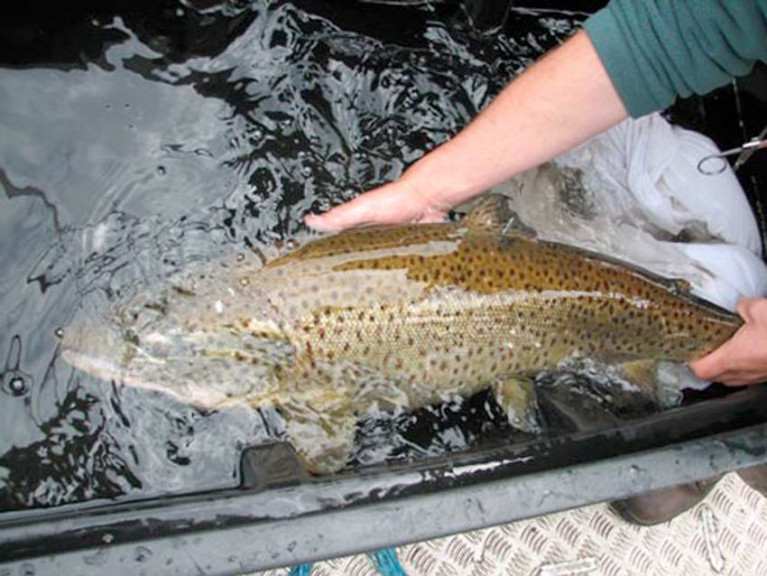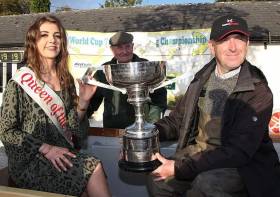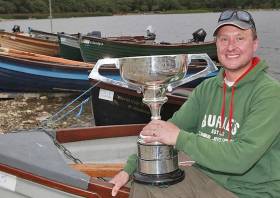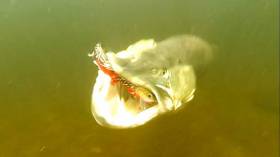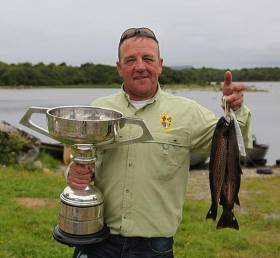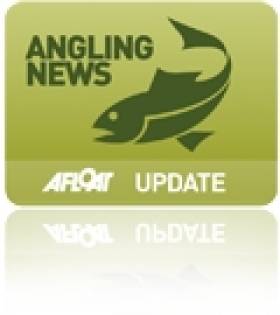Displaying items by tag: Lough Mask
Lough Mask Community Profiled on TG4 Series Bailte
The Great Western lakes village of Tourmakeady is the focus of a TV programme on TG4 this week.
The programme presented by Síle Nic Chonaonaigh is part of a series entitled Bailte which explores the resilience within townlands and rural communities.
Tourmakeady or Tuar Mhic Éadaigh, the village nestled between the shores of Lough Mask and the Partry Mountains in south Mayo, is one of over 60,000 such communities on the island.
“A picture postcard scenic area of gently rolling hills and lake views disguise a turbulent history of local persecution and our nation's fight for independence,” TG4 says.
“The world-renowned Lough Mask has for generations sustained the local community and Síle learns of the immense local pride connected with the lake,”it says.
She also “explores the generational effects of emigration but also meets with a younger generation who intend to once again return to their native village”.
The series is billed as a “celebration of hard-working and vibrant communities working to ensure their community is more than just a mere layby and a pretty spot on the Wild Atlantic Way”.
As well as the many advantages of living in rural townlands, the series also “shares the difficulties living in remote area, rural depopulation, lack of basic services, unemployment and the uncertain futures of both the farming and the fishing industries”, TG4 says.
Bailte’s profile of Tourmakeady/ Tuar Mhic Éadaigh is presented by Síle Nic Chonaonaigh this Thursday, March 30th, at 8 pm on TG4.
Tender for Galway/Mayo Blueway Feasibility Study
The Connaught Telegraph reports that Galway city councillors are tendering for a study on the feasibility of a new blueway for Galway and Mayo.
According to details on the State’s eTenders website, the proposed blueway would extend from Lough Mask to Galway Bay along the River Corrib and associated inland waterways, and include a zone some 5-10km inland.
The deadline for submissions is noon next Friday 11 June with the prospective contractor expected to conduct an analysis of the potential economic and social benefits of such a blueway, among other requirements.
New Research on Ferox Trout Highlights Its Importance to Lough Corrib & Lough Mask
A newly published research paper co-authored by experts in Ireland highlights the importance of ferox trout to the fisheries of Lough Corrib and Lough Mask.
Ferox trout are highly prized by trophy anglers, and Loughs Corrib and Mask have recorded the majority of Irish specimens since angling records began in the 1950s.
The large, long-lived, fish-eating trout are normally found in deep lakes and are believed to be genetically distinct from normal brown trout, having evolved after the last Ice Age 12,000 years ago.
Little was known about the spawning location of Irish ferox trout compared to normal brown trout, and a radio tracking study was initiated in both catchments in 2005.
Local anglers and Inland Fisheries Ireland (IFI) staff helped catch large ferox trout on both lakes in order to insert radio tags.
The fish were released after tagging and then tracked with help from the Irish Air Corps helicopter unit and by walking spawning streams with a radio tracking antenna to determine in which streams ferox spawned.
Scientists from Inland Fisheries Ireland worked with colleagues at the Norwegian Institute for Nature Research on the data collected in this study.
Results from radio tracking showed that the majority (92%) of ferox trout tagged in Lough Corrib spawned in a single spawning stream, the Cong River, while the majority (76%) of ferox trout tagged in Lough Mask spawned in the Cong canal and Cong River.
These results, as published in the Journal of Fish Biology, indicate that these streams are most likely the principle spawning locations of ferox trout in both lakes.
Dr Paddy Gargan, senior research officer at Inland Fisheries Ireland and lead author on the publication, said: “The occurrence of ferox trout predominantly in single spawning rivers in both catchments highlights the vulnerability of the ferox populations with estimates of their population size thought to be small”.
IFI’s head of research Dr Cathal Gallagher welcomed the findings and said: “It was important that conservation measures, based on this research, have been introduced in the Corrib and Mask catchments continue to protect ferox trout.
“These conservation measures have reduced the number of ferox trout being killed and claimed as specimens and support the conservation of this unique trout.”
Fly World Cup Goes To Leitrim Angler After Month-Long Championship
Leitrim angler Bernard Kilkenny claimed the World Cup in trout fly angling on Lough Mask last weekend, as Derek Evans notes in today’s Irish Times.
His five trout at 5.73lb secured the title — as well as a boat with 15HP outboard, and a new rod and reel — in what was “the most drawn-out in the 63 years of the championships”, with poor weather meaning three attempts over a whole month were required.
Elsewhere, two anglers caused a headache for marine wildlife lovers in Wicklow yesterday (Sunday 8 September) when they were spotted fishing just meters from a protected seal colony.
According to Wicklow News, the men had ignored signs warning away from the seals, as well as the pleas of several onlookers, but left the area after they were spoken to by gardaí.
It is recommended that the public stay at least 100 metres away from seals as they enter their breeding season and seek safe space on land from September to the end of the year.
Search For Angler Missing On Lough Mask
The Irish Times reports that a search is under way on Lough Mask for a fisherman who failed to return to shore yesterday (Friday 8 March).
The local man, an experienced angling enthusiast in his 70s, had set out at noon but the alarm was raised when he did not return by evening, and after weather conditions has worsened on the lake.
The man’s boat was recovered earlier today (Saturday 9 March). Gardai said searches with the Irish Coast Guard were continuing.
Fermanagh Man Takes Trout Angling World Title
#Angling - Nigel Greene was the big winner at the World Cup Trout Fly Angling Championships on Lough Mask over the August Bank Holiday, as Derek Evans writes for The Irish Times.
The Fermanagh fly fisherman bested a field of more than 450 anglers at the 62nd hosting of the event, considered “the ultimate prize in trout angling”.
Greene’s final count total of seven fish with a weight of 9.772lb put him almost half a pound over his closest rival – despite Kanturk’s Michael Twohig catching one more fish.
The Irish Times has more on the story HERE.
Connacht Anglers Fear Threat To Wild Brown Trout By ‘Predator’ Pike
#Angling - Wild brown trout in Connacht lakes face extinction due to unchecked numbers of pike, local anglers fear.
According to Galway Bay FM, the Connacht Angling Council says stocks in Lough Corrib and Lough Mask are among those under threat unless measures such as a closed season for angling and a pike cull are introduced.
Ahead of its ‘Pike are Predators – Save our Wild Brown Trout’ campaign launch this Wednesday 20 September from 8pm at the Boat Inn in Oughterard, the council has launched an online petition in the hopes of persuading Inland Fisheries Ireland to take action against the “predator” species.
Clare Angler Tops Trout Fly Worlds On Lough Mask
#Angling - Thomas O'Loughlin's impressive 12-fish catch was more than enough to snag him the top prize at the World Cup Trout Fly Angling Championship on Lough Mask recently.
The Corofin, Co Clare native's final bag of 13.43lbs was 50% larger than that of his closest rival Jonathan Craven of Connacht in the 60th running of the competition, which took place over five days ending on Monday 1 August, as the Clare Champion reports.
His victory marks the first for any Clare angler in the Lough Mask contest – but is just the latest in a series of accolades for 'Tommy', who comes from an experienced family of game anglers.
The Clare Champion has much more on the story HERE.
Lough Mask Engine Thefts Prompt Concerns
#EngineTheft - The Mayo News reports that three boat engines have been stolen from moorings on Lough Mask in Co Mayo over the last fortnight.
Two engines were reported taken at Cahir Pier, a spot popular with tourists, while the third theft occurred at Burke's Island.
“It’s prevalent around the country, and it has happened on Lough Corrib, but it’s the first time it’s happened here," said local angler Denis Kelleher about the thefts. "It’s something I had hoped would stay away from the area."
Kelleher noted that with only one road in and out of both areas, installation of CCTV might prove a deterrent to any future burglaries - though local councillor Michael Burke raised concerns about how such a system would be managed.
The Mayo News has more on the story HERE.
Mayo Angling Ups and Downs as Season Draws to Close
#ANGLING - The going is tough in the last weeks of this year's angling season on Lough Mask, as Mayo Today reports.
Though anglers are still out in good numbers despite the shortening days and drop in temperature, catch numbers are way down on the angling bonanza that marked the beginning of a season that also produced a record-breaking monster trout on nearby Lough Corrib.
The best fishing was seen at the Vintners Federation of Ireland contest on the lough two weeks ago, where the prize-winning catch was a total of seven trout for 4.21kg.
Meanwhile, Celebrity World Cup champ Mick Dunne won the Molloy Cup catch-and-release contest with his catch of five trout measuring 157cm in total.
Elsewhere in Mayo, the River Moy has been more productive, with 199 salmon reported in the seven days preceding 19 September, and Lough Conn and Lough Beltra anglers have also reported some good fishing.
The news makes up for the "relative quiet" on the Newport Rover, and the significant decrease in catches on the Ballisodare Fishery.


























